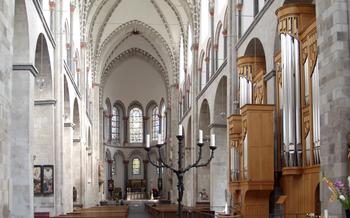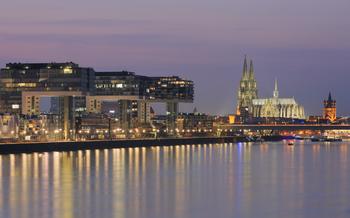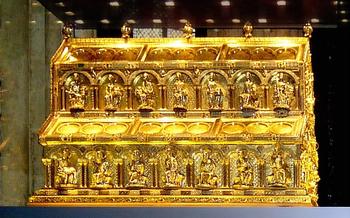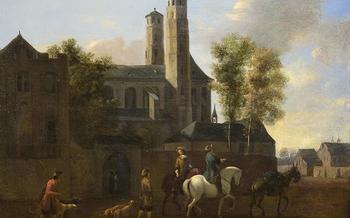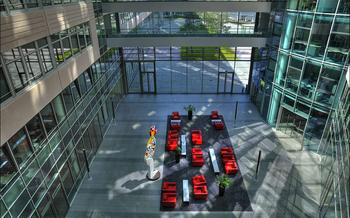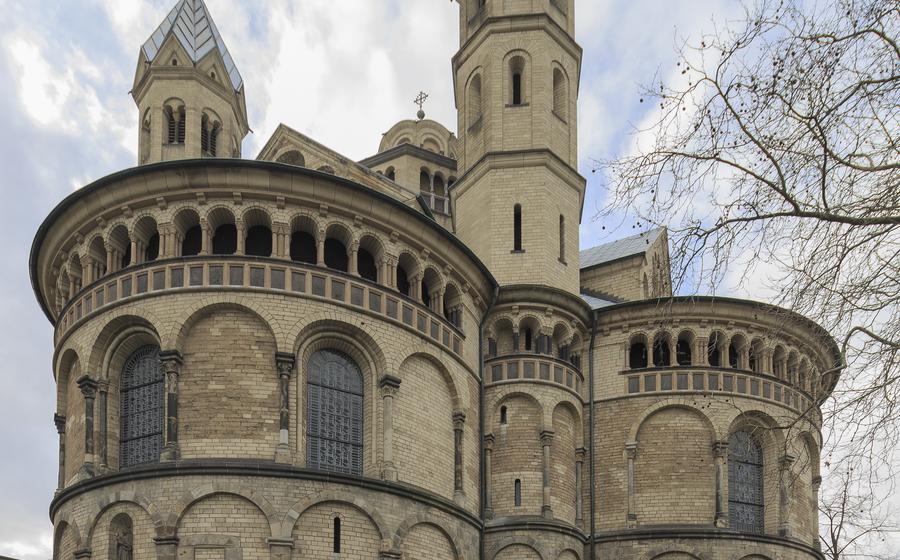
Twelve Romanesque Churches
- A City of History and Art
- The Twelve Romanesque Churches
- St. George Church
- St. Severin Church
- St. Maria im Kapitol Church
- St. Ursula Church
- Cologne Cathedral
- The Romanesque Churches Route
- Insider Tip
A City of History and Art
Cologne, a city steeped in history and boasting a rich cultural heritage, proudly stands as a testament to the harmonious blend of Romanesque and Gothic architectural styles. Stroll along the city's charming streets and marvel at the intricate facades of towering churches, each narrating a unique tale of Cologne's glorious past. The profound influence of the Catholic Church on the city's development is evident in the abundance of sacred structures, each contributing to the city's profound spiritual and cultural identity.
The Twelve Romanesque Churches
The twelve Romanesque churches of Cologne stand as a testament to the city's rich history and architectural heritage. Built between the 10th and 13th centuries, these churches showcase a remarkable blend of Romanesque and Gothic styles. Each church boasts unique architectural features that set it apart, reflecting the diverse influences that shaped Cologne's development.
The Great St. Martin Church, for example, is known for its towering Romanesque tower and intricate carvings. St. George Church is adorned with stunning stained-glass windows and vaulted ceilings, while St. Pantaleon Church features a Romanesque crypt and a Gothic choir.
These churches played a crucial role in the development of Cologne's religious and cultural identity. They served as centers of worship, pilgrimage, and learning, attracting people from all walks of life. The churches also played a significant role in the city's political and economic development, as they were often closely associated with powerful religious orders and wealthy merchants.
Today, the twelve Romanesque churches stand as a reminder of Cologne's rich past and continue to be cherished by locals and visitors alike. They offer a glimpse into the city's architectural heritage and provide a unique opportunity to experience the spiritual and cultural significance of these remarkable buildings.
St. George Church
The St. George Church, also known as the Basilica of St. George, is another prominent Romanesque landmark in Cologne. Built in the 10th century as a collegiate church, it underwent extensive renovations in the 12th and 13th centuries, blending Romanesque and Gothic elements.
Historical Background and Architectural Highlights The church holds significant historical importance as the burial site of St. Irmgardis, the patron saint of Cologne. Her relics are enshrined within the church, attracting pilgrims and visitors seeking spiritual solace. The exterior of St. George Church features a striking Romanesque tower, while the interior boasts intricate vaulted ceilings and stunning stained-glass windows, creating a harmonious fusion of architectural styles.
Notable Features Among the notable features of St. George Church are the exquisite stained-glass windows, which depict scenes from the life of Christ and the saints. These windows, crafted by renowned artists of the 13th century, bathe the interior in colorful hues, creating a mystical ambiance. The church's vaulted ceilings, supported by slender columns, add to its grandeur and create a sense of awe and inspiration.
Practical Information Visiting hours for St. George Church vary depending on the season. Admission is free, allowing visitors to explore its architectural wonders and spiritual significance at their leisure. Guided tours are available for those seeking a deeper understanding of the church's history and symbolism.
St. Severin Church
The history of St. Severin Church dates back to the 4th century, making it one of the oldest churches in Cologne. Originally a Roman basilica, it was rebuilt in the Romanesque style in the 11th century. The church underwent further modifications in the Gothic period, resulting in a harmonious blend of architectural styles.
Architectural Highlights
- The Romanesque tower, with its distinctive octagonal shape, dominates the church's exterior.
- The Gothic nave, added in the 13th century, features pointed arches, ribbed vaults, and large windows that flood the interior with light.
- The intricate carvings on the capitals and corbels depict scenes from the Bible and the lives of saints.
- The stained-glass windows, created in the 19th century, depict various biblical scenes and add a vibrant touch to the church's interior.
Practical Information
St. Maria im Kapitol Church
The history of St. Maria im Kapitol Church dates back to the Roman period, when it was built over the remains of a Roman temple dedicated to Jupiter. The church was first mentioned in the 4th century and was rebuilt in the 10th century. The current Romanesque structure was built in the 11th and 12th centuries.
Architectural highlights include the Romanesque tower, which is the oldest part of the church and is topped by a distinctive onion dome. The Gothic choir was added in the 13th century and features intricate carvings and stained-glass windows.
Practical information: - Visiting hours: Monday-Sunday, 10am-6pm - Admission fees: Free - Insider tip: Visit the church during the evening when it is illuminated and offers a magical atmosphere.
St. Ursula Church
The history of St. Ursula Church is inextricably linked to the legend of Saint Ursula and her 11,000 virgins. According to the legend, Ursula was a Christian princess from Britain who was martyred in Cologne along with her companions while on a pilgrimage to Rome. The church was built in the 12th century on the site of Ursula's martyrdom and became a popular pilgrimage destination.
The architectural highlights of St. Ursula Church include its Romanesque tower, Gothic nave, and intricate carvings. The church's interior is adorned with beautiful stained-glass windows depicting scenes from the life of Saint Ursula. The church also houses the relics of Saint Ursula and her companions, which are displayed in a golden reliquary.
St. Ursula Church is open to visitors daily from 10 am to 5 pm. Admission is free of charge. Guided tours of the church are available upon request.
Cologne Cathedral
Amidst the architectural marvels of Cologne, the Cologne Cathedral stands as a testament to the city's rich history and enduring faith. This awe-inspiring Gothic masterpiece, a UNESCO World Heritage Site, took over 600 years to complete, spanning the Middle Ages to the 19th century. Its twin spires, soaring 157 meters into the sky, dominate the cityscape and offer breathtaking panoramic views. The cathedral's intricate façade is adorned with hundreds of sculptures, depicting biblical scenes and historical figures, while the interior boasts a treasure trove of medieval art and stained-glass windows that bathe the grand space in a kaleidoscope of colors. As one of Germany's most visited landmarks and a symbol of Cologne's resilience, the Cologne Cathedral is a must-see for any traveler seeking a profound encounter with history, architecture, and spirituality.
The Romanesque Churches Route
The Romanesque Churches Route is a self-guided walking tour that connects all twelve of Cologne's Romanesque churches. The route is approximately 5 miles long and can easily be completed in a day. Along the way, you'll pass by some of Cologne's most iconic landmarks, including the Cologne Cathedral, the Old Town Hall, and the Rhine River.
To plan your self-guided tour, start by picking up a map of the Romanesque Churches Route from the Cologne Tourist Information Office. The map will show you the location of each church and provide a brief history of each one. You can also download a guided audio tour of the route from the Cologne Tourist Board website.
Once you have your map and audio tour, you're ready to start your exploration of Cologne's Romanesque churches. Simply follow the route from one church to the next, listening to the audio tour as you go. Be sure to take your time and savor the unique architecture and history of each church.
If you're short on time, you can choose to visit only a few of the churches on the route. However, if you have a full day, we recommend visiting all twelve churches. The route is a great way to learn about Cologne's history and culture, and it's a beautiful way to see the city.
Insider Tip: To make the most of your experience, visit the churches during the week when they are less crowded. Also, be sure to dress respectfully, as these are still active places of worship.
Combine the Route with Other Cologne Attractions: The Romanesque Churches Route can easily be combined with other Cologne attractions. For example, you could start your day by visiting the Cologne Cathedral, then follow the route to visit the other churches. You could also end your day by taking a boat tour of the Rhine River.
No matter how you choose to experience it, the Romanesque Churches Route is a must-do for any visitor to Cologne. It's a great way to learn about the city's history, culture, and architecture.
Insider Tip
Venture beyond the renowned Twelve Romanesque Churches to uncover the hidden gems that Cologne has to offer. Explore smaller, lesser-known churches, each with its own unique charm and history. Wander through the vibrant streets, immersing yourself in the city's energetic arts and culture scene. Discover independent galleries showcasing local talents, attend captivating performances at intimate theaters, or groove to the rhythm at live music venues.
Indulge in Cologne's culinary delights, savoring the local specialties that have delighted generations. Sample the famous Kölsch beer, a refreshing golden ale brewed in accordance with strict purity regulations. Pair it with hearty German cuisine, such as the beloved Himmel un Ääd (blood sausage with mashed potatoes and apple sauce) or the traditional Rheinischer Sauerbraten (marinated beef pot roast). Experience the warmth and hospitality of Cologne's people, who are always ready to share their stories and recommendations.


